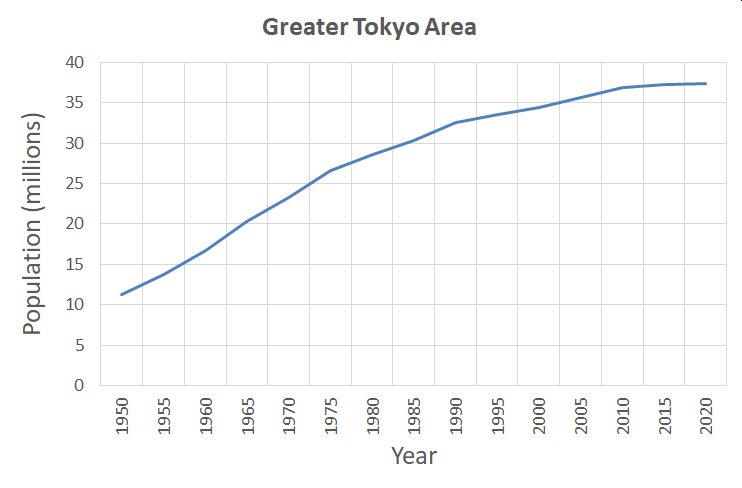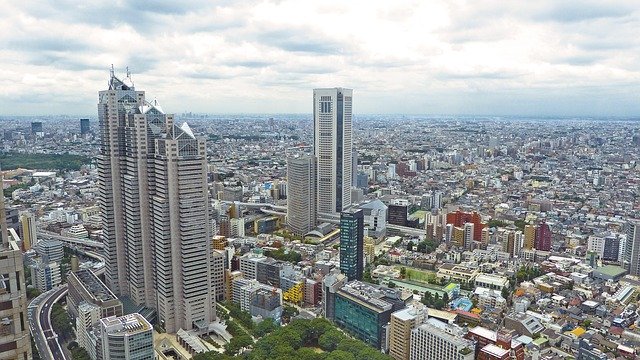Tokyo megacity
Contents |
[edit] Introduction
Megacities are metropolitan areas with a total population of more than 10 million people. The definition of what constitutes a megacity generally refers to an urban agglomeration, that is, it includes people living in the immediate suburbs outside of the established border of the city.
Megacities are a distinctly modern phenomenon, the proliferation of which has spread with large-scale urbanisation around the world. Whereas only 3% of the global population lived in cities in 1800, by the end of the 20th century that figure had risen to 47%. It is expected to reach more than 70% by the second half of the 21st century, a number made even more startling by the fact that the global population is projected to increase by two billion by that point.
Historically, the growth of big cities first occurred during the industrial revolution when large numbers of people moved to urban areas to find work - a trend broadly associated with developed nations. In contrast, contemporary megacities are focused in Asia.
[edit] Greater Tokyo Area
Tokyo was recognised along with New York as one of the first megacities when the term came into common use in the 1950s. While New York has dropped in its ranking, the Greater Tokyo Area is now the largest megacity in the world with a population of 37.4 million in 2020. For more information see: Megacities.
Ref Time Series of the Population of the 30 Largest Urban Agglomerations in 2018 Ranked by Population Size, 1950-2035. https://population.un.org/wup/Download/
Tokyo's growth has occurred despite numerous natural and human-made disasters. In 1923 the city was rocked by the Great Kanto Earthquake, and on 11 March 2011, a another major earthquake hit Japan, although Tokyo was largely spared. Much of the modern the city emerged from destruction after heavy bombing during World War II.
[edit] The megacity designation
The Greater Tokyo Area (also referred to in Japan as the Capital Region) incorporates the Kanto region (which includes the Tokyo metropolitan area along with Kanagawa, Chiba, Saitama, Ibaraki, Tochigi and Gunma) and the Yamanashi prefecture (which is part of the adjacent Chubu region). It is a major financial centre, and according to 2017 statistics, it has the largest metropolitan economy in the world.
An extensive public transit system and cycle network have helped to reduce automobile traffic and support movement throughout the region, although cycle lanes are often disregarded by delivery vehicles. The government has been investigating additional ways of reducing air pollution, traffic congestion and noise while managing crime and litter. Green initiatives (such as solar energy and tree planting) are also being introduced.
Creating a balanced urban environment has resulted in some stability in the Greater Tokyo Area, although continued growth is uncertain because of the country’s ageing population and the lack of undeveloped land in the surrounding area. People from other parts of Japan are still moving to Tokyo, in part, due to the affordability of high-rise housing built in the decades after the global economic downturn of 1991.
[edit] Tokyo and the Olympics
Construction and infrastructure work increased in the Greater Tokyo Area in the lead up to the 2020 Olympics (which has been postponed due to the 2020 Covid 19 pandemic).
The majority of the sporting venues for the Games are located in or around the Greater Tokyo Area, with several facilities repurposed from the Olympics held in Tokyo in 1964. Railway lines around the city’s airports and automated transit lines have also been developed, along with highway refurbishment to support traffic in and around the city.
[edit] Related articles on Designing Buildings Wiki
- Built environment.
- Changing lifestyles.
- Cities as systems - BRE Solutions for urban environments.
- City Beautiful.
- Densification.
- Eco towns.
- Global Construction Megacities 2017.
- Infrastructure.
- Landscape urbanism.
- Masterplanning.
- Megacity.
- Megatrends: Globalisation.
- Metro cities - the future of urbanisation.
- Must cities grow to compete?
- Smart cities.
- Urban design.
[edit] External references
- Has Tokyo reached 'peak city'? The Guardian, 14 June 2019.
- Tokyo became a megacity by reinventing itself. National Geographic, 17 February 2014.
Featured articles and news
Government consultations for the summer of 2025
A year of Labour, past and present consultations on the environment, the built environment, training and tax.
CMA competitiveness probe of major housing developers
100 million affordable housing contributions committed with further consultation published.
Homes England supports Greencore Homes
42 new build affordable sustainable homes in Oxfordshire.
Zero carbon social housing: unlocking brownfield potential
Seven ZEDpod strategies for brownfield housing success.
CIOB report; a blueprint for SDGs and the built environment
Pairing the Sustainable Development Goals with projects.
Types, tests, standards and fires relating to external cladding
Brief descriptions with an extensive list of fires for review.
Latest Build UK Building Safety Regime explainer published
Key elements in one short, now updated document.
UKGBC launch the UK Climate Resilience Roadmap
First guidance of its kind on direct climate impacts for the built environment and how it can adapt.
CLC Health, Safety and Wellbeing Strategy 2025
Launched by the Minister for Industry to look at fatalities on site, improving mental health and other issues.
One of the most impressive Victorian architects. Book review.
Common Assessment Standard now with building safety
New CAS update now includes mandatory building safety questions.
RTPI leader to become new CIOB Chief Executive Officer
Dr Victoria Hills MRTPI, FICE to take over after Caroline Gumble’s departure.
Social and affordable housing, a long term plan for delivery
The “Delivering a Decade of Renewal for Social and Affordable Housing” strategy sets out future path.
A change to adoptive architecture
Effects of global weather warming on architectural detailing, material choice and human interaction.
The proposed publicly owned and backed subsidiary of Homes England, to facilitate new homes.
How big is the problem and what can we do to mitigate the effects?
Overheating guidance and tools for building designers
A number of cool guides to help with the heat.
The UK's Modern Industrial Strategy: A 10 year plan
Previous consultation criticism, current key elements and general support with some persisting reservations.
Building Safety Regulator reforms
New roles, new staff and a new fast track service pave the way for a single construction regulator.



























